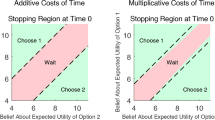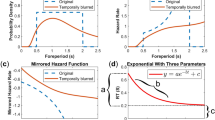Abstract
SIMPLE reaction time tasks usually contain procedures designed to reduce or eliminate the frequency with which subjects anticipate the onset of the stimulus. These measures include varying the interval or foreperiod between the warning stimulus and the subsequent stimulus, and introducing a number of “catch trials” on which the stimulus does not follow the warning. Obviously, one effect of including catch trials is to lower the overall probability that the stimulus will follow the warning stimulus. In view of the known importance of stimulus probability in choice reaction time situations, it is perhaps surprising that, although there have been several studies (for example, refs. 3–5) of the effects of changes in the range and variability of foreperiods, there appears to have been only a single study in which the effect of changing the frequency of catch trials has received systematic investigation. Drazin2 introduced catch trials to produce three levels of probability of occurrence of the stimulus (s): P(s) = 1.0, 0.9 and 0.5. These levels were allowed to interact with mean fore-period, so that Drazin's results regarding the effects of P(s) on reaction time are limited to the demonstration of (1) an inverse relationship between P(s) and reaction time, and (2) an interaction between P(s) and the reaction time–foreperiod relationship. The study reported here was designed to examine the relationship of the P(s) and reaction time over a wide range of P(s) values in a sequential, simple reaction time situation.
This is a preview of subscription content, access via your institution
Access options
Subscribe to this journal
Receive 51 print issues and online access
$199.00 per year
only $3.90 per issue
Buy this article
- Purchase on Springer Link
- Instant access to full article PDF
Prices may be subject to local taxes which are calculated during checkout
Similar content being viewed by others
References
Annett, J., Quart. J. Exp. Psychol., 18, 273 (1966).
Drazin, D. H., J. Exp. Psychol., 62, 43 (1961).
Karlin, L., J. Exp. Psychol., 58, 185 (1959).
Klemmer, E. T., J. Exp. Psychol., 51, 179 (1956).
Woodrow, H., Psychol. Monog., 17 (5,Whole No. 76).
Author information
Authors and Affiliations
Rights and permissions
About this article
Cite this article
GORDON, I. Stimulus Probability and Simple Reaction Time. Nature 215, 895–896 (1967). https://doi.org/10.1038/215895a0
Received:
Revised:
Issue Date:
DOI: https://doi.org/10.1038/215895a0
This article is cited by
-
Peripersonal Space from a multisensory perspective: the distinct effect of the visual and tactile components of Visuo-Tactile stimuli
Experimental Brain Research (2022)
-
Additive and interactive effects of spatial attention and expectation on perceptual decisions
Scientific Reports (2018)
-
Why free choices take longer than forced choices: evidence from response threshold manipulations
Psychological Research (2018)
-
The influence of stimulus duration on visual illusions and simple reaction time
Experimental Brain Research (2012)
-
Sequence effects in a spatial cueing task: Endogenous orienting is sensitive to orienting in the preceding trial
Psychological Research (2007)
Comments
By submitting a comment you agree to abide by our Terms and Community Guidelines. If you find something abusive or that does not comply with our terms or guidelines please flag it as inappropriate.



